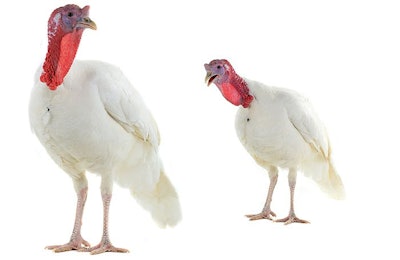
The turkey reovirus is an emerging challenge in the industry, which will require collaborative action among researchers, breeders and growers to solve.
On March 19, 2020, Dr. Genevieve Huard, a professional specializing in veterinary services at Hybrid Turkeys, spoke about reovirus in poultry. She spoke via a webinar due to the cancelation of the Midwest Poultry Federation Convention as a result of to the global outbreak of the novel, human coronavirus known commonly as COVID-19.
Myth 1: All leg problems are reovirus
Reovirus is a wider name for specific viruses that infect turkeys and chickens, and cause a range of health problems, most notably enteritis in poults. In recent years, however, the disease is contributing to the development of leg and joint problems like arthritis which cause lameness in turkeys in North America.
Huard said the reovirus is a complex pathogen attracting more concern as it grows in prevalence in the poultry industry. It is not the most well understood malady in the poultry industry. The virus mutates quickly, often making tracing the disease back to its origin difficult.
Nevertheless, the reovirus cannot be blamed for all leg problems. She said the only way to confirm the presence of the reovirus is for a veterinarian to perform a necropsy. Leg problems are potentially caused by numerous issues – nutrition, bacterial infection, development issues, etc. – along with the reovirus.
One key way to identify reovirus’ effects in turkey hocks is swelling in the legs, particularly above the hock. However, this is not a phenomenon exclusive to the virus, so a veterinary diagnosis is needed to confirm the presence of reovirus.
Myth 2: Chickens are the cause of reovirus
Reovirus, Huard said, is ubiquitous in the poultry industry and not all viruses in the family Reoviridae are problematic. The only way to determine which species is infecting a flock is through testing.
She also dismissed the claim some reoviruses are breed specific. Reoviruses are species specific, meaning a chicken cannot infect a turkey and vice versa, but they do not infect one breed of turkey while another is immune.
Myth 3: The virus comes from the poults
Huard said the disease can spread vertically – from parent to child – and the breeder industry is working on how the virus spreads and how that transmission can be limited. The disease is also spread horizontally – from bird to bird on the farm – so farmers have a role to play in limiting disease transmission on site.
The reovirus is potentially spread through the birds’ environment and from bird to bird. According to studies of chicken reovirus, it can live in water for weeks, survive in feed, litter and soil, and be spread by insects like darkling beetles as well as on the birds’ feet.
The disease is hardy, which makes cleaning and disinfection of facilities more difficult, but is not invincible. The goal for both the breeders and the growers should be to reduce the potential disease challenge faced by poults and pullets before they are placed in a house. The birds are more susceptible at a younger age. Vaccination by breeders is a vital part of the control strategy to prevent transmission and virus shedding on farm.
Conclusion
The ultimate goal of the turkey industry, Huard said, is eradication of the highly pathogenic turkey reovirus, but right now it lacks the knowledge and the tools needed to do so. She said better understanding of the disease and better diagnostic tools for better control as well as more research into more effective vaccines.
For now, the goal is to establish the best possible reovirus control program which requires multiple approaches and different levels and cooperation between researchers, breeders and commercial growers. Enhanced biosecurity at every level of the operation is essential, too.
















